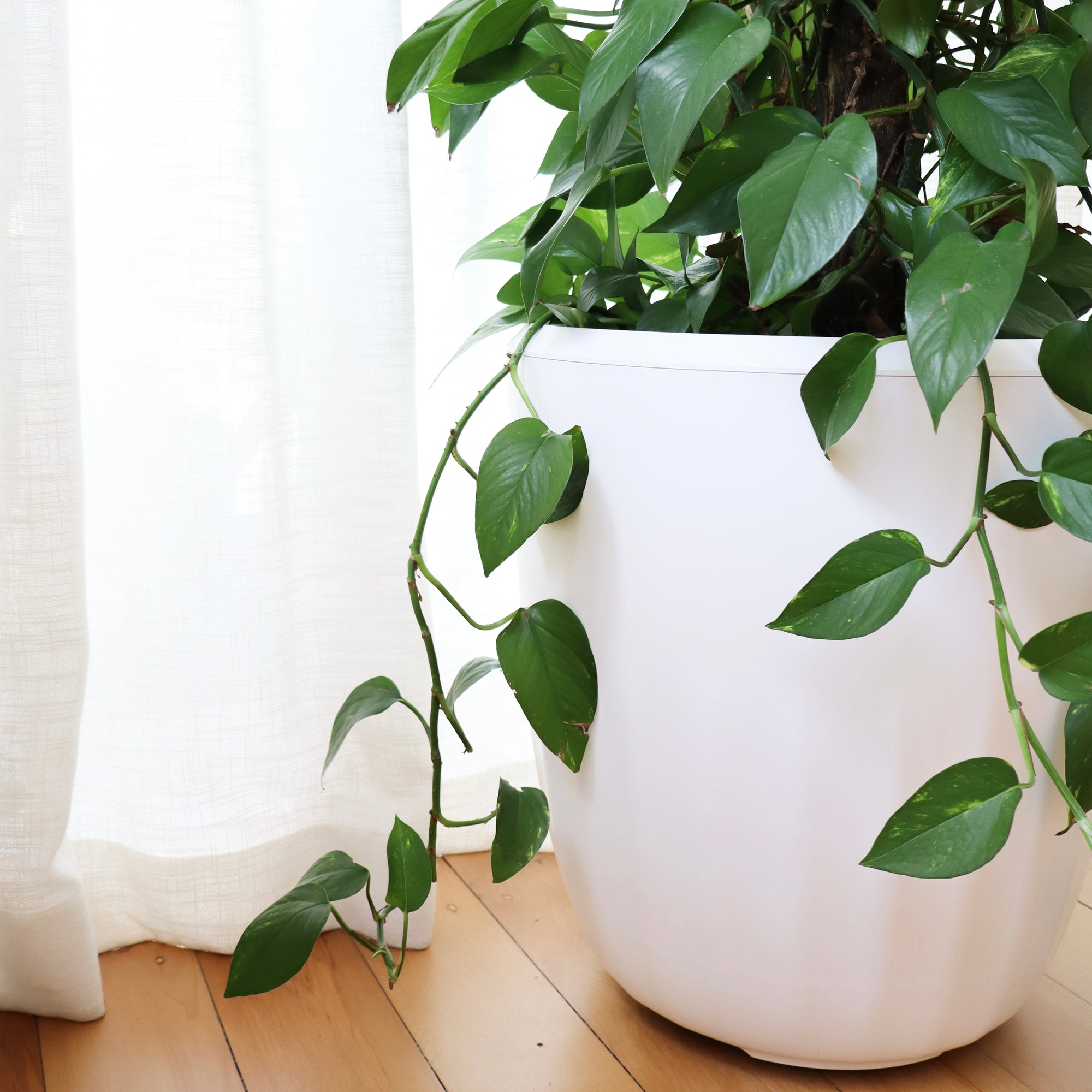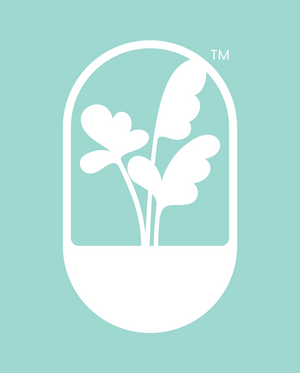
Choosing the Best Plant Pots for Your Plants - We Break Down the Options and Tell You What You Need to Know
Choosing the Right Plant Pot: The Good, The Bad and The Stinky...
Choosing the best plant pots is one of the most important decisions you will make throughout your plant-life journey.
You need to consider a range of factors including:
- the variety and size of the plant
- whether they're outdoor or indoor plants
- the needs of the plants and the care required
- style preferences and desired functionality.
There is no one-size fits all pot size or type, and most pots on the market right now come with different advantages and disadvantages.
Decorative Plant Pot with Drip Tray

(Source: amazon.com.au)
Decorative pots are the neat freaks of the plant world and tend to be suited to indoor plants that are small and low maintenance. They also work well for outdoor plants. Plant owners can remove their plants from their nursery pots and plant them directly into the decorative planter.
When used indoors or on balconies and terraces, they usually require a drainage saucer (also called a 'drip tray'), which provides a buffer against leaky puddles.
Pros & Cons of Using a Decorative Pot
(PerkyPod versus other plant pots: pros and cons)
Advantages
Using a single decorative pot means you’re not trying to match the sizes of an internal and external pot (like the double potting option, below) so the appearance of your plant is minimal and tidy.
It can be a relatively cheap option, especially if you use a terracotta planter or a plastic pot. Plastic or fibreglass versions may be lightweight too - which is perfect if you’re the type of plant parent that prefers to do watering sessions somewhere where the drips won’t leave a mess.
Disadvantages
Many decorative pots do not have any drainage holes, yet drainage is essential to avoid drowning plant roots. Also, unless water is dripping out the bottom of your pot, how do you know every root has had a drink?
If there is a drainage hole, a drip tray can provide a small amount of puddle protection. As it can be very difficult to judge exactly how much water your plant’s roots and the soil will drink, you can be left with an overflowing mess.
On the other hand, trying to avoid mess means many plant parents underwater, which results in dehydrated and droopy plants. Plants will require attention more regularly, as you will need to monitor the soil moisture and water intake.
Decorative pots can become too heavy for larger plants, which may prevent owners from relocating for watering, or moving them around for floor cleaning, chasing sunlight or experiment with different positions around their home or garden.
Finally, many decorative pots only contain one drainage hole. Over time, this single hole can become clogged with escaping soil and/or plant roots. Once this occurs, the drainage hole ceases to be functional and the plant will drown. It is very hard to recover a plant once this occurs.
Double potting

(Source: laidbackgardener.blog)
This is the most popular potting technique for indoor plants. Plants are kept in a lightweight nursery pot within a larger decorative pot. They’re Instagram-ready in a snap and your plants are lightweight enough to move when the mood strikes.
Pros & Cons of Double Potting
Advantages
Watering is easy, as the decorative pot (provided it has no drainage holes) is able to catch excess water. This means plants can be soaked, which avoids underwatering. If the decorative pot has drainage holes, a drip tray will be needed to avoid puddles.
Commonly, the plant is relocated to a sink, bathroom or lawn for watering. This reduces inconvenient messes and also stagnant water pooling inside decorative pots that don't have any drainage.
Disadvantages
Some common disadvantages with the double potting method are over-watering and physical exertion.
If you leave the plant within the decorative pot for watering, water will not be visible dripping out the bottom of the nursery pot, so it will be hard to determine if the plant has received enough. Also, excess water may pool in the base of the decorative pot, leading to over-watering as the bottom roots are left to rot. A decorative pot without drainage holes will also lead to stagnant water, which becomes a foul, smelly breeding ground for algae and plant pests.
Alternatively, if you move your plants elsewhere for watering, this can take a lot of time! This is especially the case when you add in the wait time for the plants to finish draining do you don't end up drippy slip hazards on your floors.
Moving plants around is not a convenient option when you have a lot of plants, or large plants. These limitations are a reason why plant parents decide to own fewer plants and smaller plants.
Self-watering pots

(Source: mrkitly.com.au)
These have a reservoir in the base and rely on your plant’s roots wicking up water. Water is meant to be poured directly to the reservoir, which means your plant can take care of itself. If you believe the hype, these pots help you enter the realm of ‘set and forget’ plant care!
Pros & Cons of Self-Watering Pots
Advantages
This method of infrequent watering appears to be low-maintenance. You shouldn’t need to worry about routinely watering your plant and you may never have to worry about leaky messes on your floors.
Further, as their false bottom usually provides great drainage, this helps prevent root rot (the main reason why plants die) much more than relying on the sole drainage hole found in most decorative pots. If you’ve had to deal with the putrid, swampy mess caused by a clogged drainage hole, you’ll understand the importance of this.
Disadvantages
They are usually made of cheap plastic, which isn’t an attractive aesthetic. Also, many plants such as those with robust root structures and edibles (especially herbs and some vegetables) simply need more water than what is provided via wicking.
Perhaps even more problematic is the stagnant water in the reservoir, which can attract pests and algae, and is prone to forming unattractive calcium stains on the external sides of the pot.
Finally, it can be impossible to see when the water reservoir is empty, so your plant may be dying from dehydration without you even noticing. Worse still: if a plant isn't thriving, it may be tempting to water over the top of the plant. However, if the reservoir is already full of water, this is extremely hard to tip out so adding more water will lead to leaky puddles.
I've written a separate blog about self-watering plant pots here, which has more information.

(PerkyPod self-draining plant pot vs self-watering plant pot: pros and cons)
PerkyPod - innovative self-draining pot
The only way to solve all the disadvantages of the above potting methods is by using a planter pot like PerkyPod. Its innovative internal drainage and water catchment system allows you to water your plants really well without moving them. There's no stress about where the overflowing water is going. Fully saturating plants is the most effective way to create healthy plants that remain perky for extended periods between watering sessions.
But what makes PerkyPod different from self-watering pots?
PerkyPod uses a patent-pending filter and funnel system that diverts excess water into a water catchment drawer, which can be removed and tipped out at any time that suits you. It's the world's first self-draining pot! You can recycle the water for another purpose (such as watering other plants), or keep it there for the next watering session.
PerkyPod is perfect for time-poor plant parents - no more dealing with messes or waiting around, while also avoiding any back-breaking lifting. Not only will plant chores become quick and easy, but you will be able to fill your home and garden with more perky plants for less effort. Now you can own larger plants (and more of them!) because you don’t need to move them for watering.
As an added bonus? If you include PerkyPod's optional castor wheels, you’ll also be able to move your plants around to suit light conditions, to vacuum or mop… or even just your mood. Brilliant!
(PerkyPod view from underneath which shows the hidden optional castor wheel system)
As you embark on your journey to find the perfect pot for your plants, remember that each potting method has its own personality quirks. But, if you'd like to spend more of your time admiring your home garden and less time worrying about it, try a PerkyPod pot instead!



